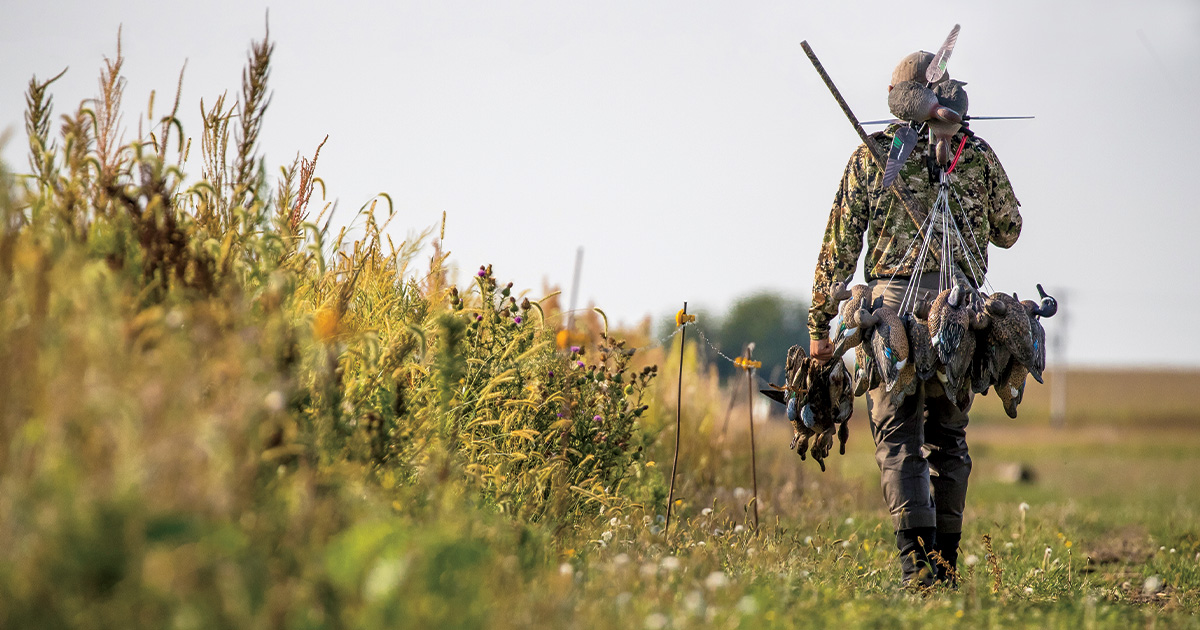Waterfowler's World: First Come the Teal
There's nothing like a September teal hunt to kick off the waterfowl season
There's nothing like a September teal hunt to kick off the waterfowl season

By Bill Buckley

Gear for early-season teal hunting should include two or three dozen decoys, spinners, a teal call, and plenty of insect repellent.
Although the hardier American green-winged teal will linger in many states up and down the flyways through much of the regular season, blue-winged and cinnamon teal are early migrators, heading south from their breeding grounds with the first cool fronts of late summer. Mature drakes are the first to leave, followed by juveniles and hens. With the migration thus under way, September teal season is a wonderful way to work the kinks out of your shooting form and enjoy what is for many hunters a fleeting chance to hunt these tasty little speedsters.
Following are some tips to help you be ready when the teal arrive.
Like most dabblers, teal love shallow water with plenty of vegetation along the edges for both food (plants, invertebrates, and seeds) and cover. In northern regions, marshes, sloughs, and potholes are likely haunts. In the south, coastal marshes and flooded agricultural fields, in particular rice fields, are prime areas. Unless you're hunting near the Gulf Coast, where many bluewings winter, plan to scout immediately before your hunt. Bluewings are often here today, gone tomorrow.
Doug Miller, operations manager at Grosse Savanne Lodge in southwest Louisiana, hunts rice fields almost exclusively. "Teal season fits perfectly with our farming practices," he says. "Immediately after our first harvest in mid-August, we'll plow openings of one to two acres next to levees, where we set temporary blinds. The fields are then reflooded. These roughly six-inch-deep openings are perfect for setting out decoys and for the teal to land and feed on leftover grain. While we might hunt marshes later on, these migrators arrive hungry, making plentiful food sources prime spots."
Teal hunts are pretty laid-back. Unlike the regular season, when high-flying, circling ducks make well-concealed blinds a must, fast, low-flying teal aren't particularly wary. As long as you stay still and your face is not shining, you're good to go. That said, camouflage with more green than brown will better match the vegetation this time of year.
Decoys are a simple matter. Two dozen to three dozen teal decoys placed in open water will more than suffice. So will a dozen mallards. To match the birds' brown plumage (the drakes resemble hens this time of year), some hunters use only hen decoys. Miller says that's not necessary, because early teal aren't picky. One thing you should include in your spread is a spinning-wing decoy or two-they're deadly on teal. So too are blue-winged teal calls like those from Haydel's, although blowing a series of short, excited quacks through a raspy mallard call can be just as effective.
Being small and often erratic targets, teal don't require stout loads or tight patterns. If there's ever a time for a 20- or 28-gauge duck gun, this is it, although a 12-gauge is perfectly fine. Regardless, you'll hit and cleanly kill more teal using an open choke combined with a light load of number 4 or 6 shot. Shooting percentages will also increase if you hold off shooting birds on their erratic, and often sudden, first pass and wait until they swing around to light in the decoys. Needless to say, a few rounds of skeet during the summer might serve you well.
Something that will definitely improve your shooting percentage is facing your blind away from the sun, preferably with the wind at your back. With this setup, you won't be squinting in harsh sunlight. You'll also be able to identify and track your targets better, as the birds will be squared up and facing you on their final approach. Be aware that to minimize the possibility of shooting non-teal species, many states start shooting hours at official sunrise, not a half hour prior.
Teal season is often a hot-weather pursuit. Wearing breathable waders or hip boots will be far more pleasant than neoprene, and light clothing is a must. But stick with long sleeves. "Mosquitoes are a big deal in September," Miller cautions. "Dress appropriately and bring your Thermacells-they really make a duck blind tolerable. Don't forget bug repellent. While you're at it, always watch out for snakes, both when wading to the blind and before you get in. Down south they're a fact of life."
Ducks Unlimited uses cookies to enhance your browsing experience, optimize site functionality, analyze traffic, and deliver personalized advertising through third parties. By continuing to use this site, you agree to our use of cookies. View Privacy Policy